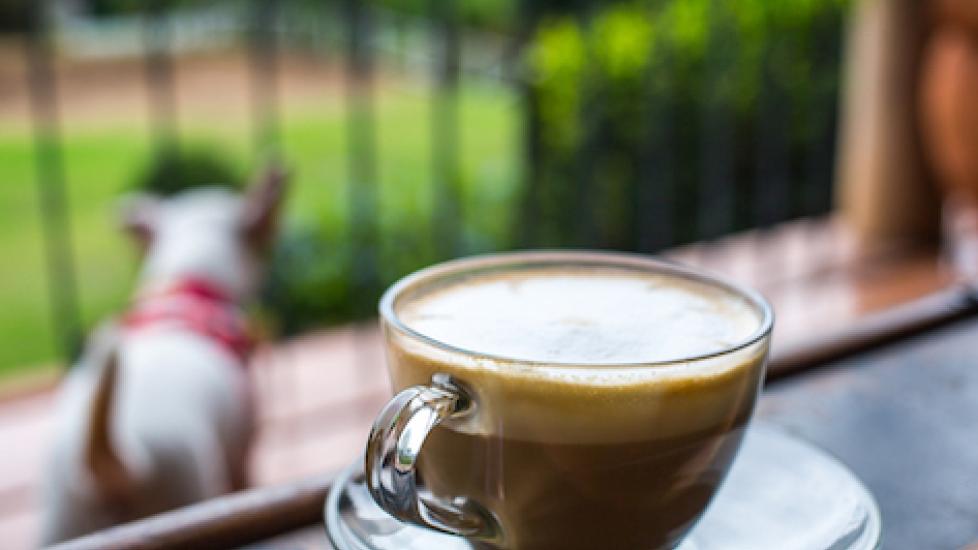Caffeine and Pets: Safety Tips and Considerations
By Helen Anne Travis
Coffee. Soda. Tea. When it comes to caffeine, many of us humans can’t go a day without our beverage of choice. But what effects, if any, does caffeine have on our pets?
It turns out our pets react in much the same way we do. Caffeine makes them restless. They get jittery and their hearts start to race. But because our pets weigh so much less than we do, it only takes a relatively small amount of caffeine to cause a big problem, potentially leading to expensive hospitalization or even death.
Here’s everything you need to know about caffeine toxicity in dogs and cats, what to do if you suspect your pet has consumed caffeine, and how to keep your furry companions safe.
Is Caffeine Safe for Pets?
“Cats and dogs should not ingest any caffeine,” says Dr. Elisa Mazzaferro, adjunct associate clinical professor of emergency-critical care at Cornell University College of Veterinary Medicine in Ithaca, New York.
If pets do ingest caffeine, it can take just 30 minutes to an hour to reach peak concentrations in their bloodstream and cause signs of clinical toxicity, she says.
Symptoms will depend on the size of the animal and the amount of caffeine consumed, adds Dr. Cathy Meeks, a board-certified internal medicine specialist and a group medical director at BluePearl Veterinary Partners in Tampa, Florida.
“Coca-Cola has less caffeine than caffeine tablets,” she says. “And a Chihuahua can tolerate a different amount than a German Shepherd.”
Call your veterinarian immediately if you believe your pet has consumed caffeine. You can also call the Pet Poison Helpline or ASPCA Animal Poison Control, Mazzaferro says.
Have ready an estimate of your pet’s weight and the amount of the caffeine-containing substance they may have gotten into so the experts can determine their potential risk.
Signs Your Pet Has Consumed Caffeine
Dogs and cats may exhibit clinical signs of caffeine toxicity within 30 to 60 minutes of consumption, Mazzaferro says. Symptoms to watch for include restlessness, agitation, hyperactivity, vomiting, and panting, she says. As the toxicity progresses, they may also exhibit tremors and seizures.
You may even be able to feel your pet’s heart racing beneath his or her fur, Meeks says. If your pet develops an extremely rapid or irregular heartbeat, it could lead to death, she says. Clinical signs can last for six to 12 hours or more, depending on the dose of caffeine ingested.
When comparing typical 8-ounce servings of popular caffeinated beverages, brewed coffee contains roughly 95 to 165 milligrams of caffeine, compared to brewed black tea at 25 to 48 milligrams, soda (Cola) at 24 to 46 milligrams, and energy drink at 27 to 164 milligrams, according to the Mayo Clinic. Meanwhile, a single caffeine tablet usually contains 200mg of the stimulant. Ingestion of 14 milligrams of caffeine per pound of body weight can lead to signs of restlessness and agitation in dogs and cats, Mazzaferro says, while higher doses (23-27 milligrams per pound of body weight) can lead to cardiotoxicity. In other words, a single caffeine tablet contains enough of the medication to be very dangerous to an eight pound dog or cat.
Treating Caffeine Toxicity in Pets
Depending on how quickly you’re able to bring your pet in, your veterinarian may be able to induce vomiting to prevent further absorption of the caffeine, Meeks says. Both experts advise against trying to induce vomiting on your own. “It could lead to aspiration pneumonia if done incorrectly,” Meeks says. “It’s much safer to do in the clinical setting.”
If your veterinarian cannot induce vomiting in time, he or she may give your pet intravenous fluids to help flush the caffeine from the body, Mazzaferro says. Your veterinarian may also administer medications to control abnormal heart rhythms, slow a dangerously elevated heart rate, and control tremors and seizures.
It takes about 24 to 48 hours for the caffeine to pass through the animal’s system, Meeks says. As long as they get treatment in a timely manner, most pets will survive.
How to Keep Your Pets Safe
One of the reasons cats and dogs are so sensitive to caffeine is their indiscriminate eating habits, Mazzaferro says. They tend to consume a lot of whatever contains the toxin in a single setting. “Because dogs and cats rarely drink caffeinated beverages, they are usually exposed by ingestion of over-the-counter stimulant medications, such as Vivarin, Dexatrim diet pills, and Excedrin,” she says. (Vivarin and Dexatrim contain about 200 milligrams of caffeine per pill, while Excedrin contains 65 milligrams per pill, as well as other potentially dangerous drugs.) If your pet consumes a medication like Excedrin, tell your veterinarian so he or she can also monitor for signs of acetaminophen and aspirin toxicity, Mazzaferro says.
To keep your pets safe, keep all medications, as well as caffeine-containing products like coffee beans, powder, or grounds; tea bags; and chocolate products, far out of reach from pets. “A lot of people don't realize an espresso bean could be toxic,” Meeks says. “But a dog is more likely to eat a chocolate-covered espresso bean than a caffeine pill. Make sure anything that could be tasty is not within their reach.” One little “treat” can be really high in caffeine and other substances that can make pets very sick.
